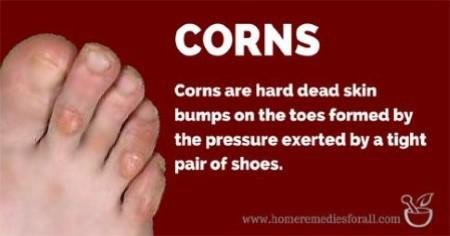Corns and calluses are the built up of hard dead skin on your toes. They can appear as bumps or a layer of thick, hard, dead skin. Corns usually appear on the toes and calluses reside on the bottom of your feet.
Too much pressure or rubbing caused by a tight pair of shoes are the main causes of painful corns and callus formation.
The early stage symptoms are indicated by bruised red skin on toes. When you wear tight shoes for longer periods daily and wear them day after day, then you would see the corns developing and growing on your toes. Calluses form in the same way.
It goes without saying that you would have already stopped using a tight pair of shoes, and are now using comfortable shoes, sandals or slippers.
Since it is a dead skin, there is a temptation to cut it off. The logic is right. In some cases, removing the corn by surgery may be the only option but that is rare. Please avoid self surgery; let a surgeon do its job if that is what is required.
1. Moisturize Corn or Callus
Corns can heal itself, if kept properly moisturized. You don’t have to use any commercially available chemical moisturizers, instead use natural products.
Calendula Oil
Calendula also known as pot marigold is a very powerful skin healing agent. It can be used in both hard and sensitive skin.
Apply Calendula oil or Calendula salve twice a day on the corn. Wrap the affected area by a bandage. This will slowly soften the skin and the corn will disappear. Continue to use Calendula until the corn is healed.
Caster Oil
Castor Oil is also a great moisturizer for hard skin. Use Castor oil in the same way as the calendula oil twice a day. Apply castor oil on the corn or callus and wrap it with a bandage. Do it until the callus or corn is healed.
2. Non Medicated Corn Pads
Medicated corn pads are harmful as the strong chemicals used to soften the hard skin of corns and calluses can burn the normal skin around the affected area.
You should wear the corn pads every day. They are a level higher than the corn so the corn doesn’t get rubbed by the shoe. Just wearing the pads for couple of weeks can heal the corn completely.
You can expedite the healing by applying calendula or caster oil on the corn. Wear the corn pad and use a cotton swab to get the oil into the hole in the pad. This will moisturize the corn. Then you can cover the hole with adhesive tape to keep the oil in place.
3. Scrub out the Calluses
You can use special scrub to slowly smoother your calluses. Take a teaspoon of Calendula oil and a teaspoon of sea salt. Add sea salt to the oil and keep it for five minutes. The granular sea salt will not dissolve into the oil. You can add 3 drops of lavender oil or any other essential oil of your choice more soothing effect.
Scrub the callus for 5-10 minutes with the sea salt oil mixture. The Calendula oil will soften the callus and the salt will do the scrubbing. You can do twice a day, once at bedtime, and the other early in the morning after waking up. The essential oil provides a bit of required relaxation effect during and after the scrub.
4. Pumice Stone
This is another scrubbing method. Both the above and this scrubbing method work better on calluses than on corns because calluses are flatter and are easier to scrub on. You have to be a little extra careful, in case of scrubbing corns.
First of all apply caster oil or Calendula oil on the corn or callus. Use Pumice Stone to scrub the area for 3-5 minutes. Once again apply one of the mentioned oil and wrap the corn or callus with a bandage.
Do it twice a day. Early mornings and before going to bed are the best times. This provides a regular interval of about 12 hours. Continue the practice until the corns or calluses are healed.
Most likely your corns will disappear with the use of any one of the above methods but if they don’t then show it a podiatrist who can surgically remove it.

